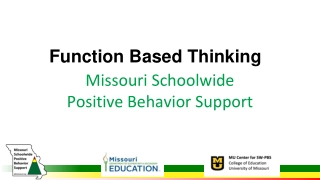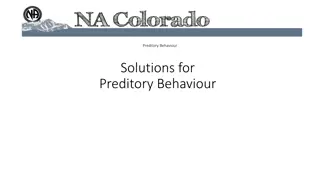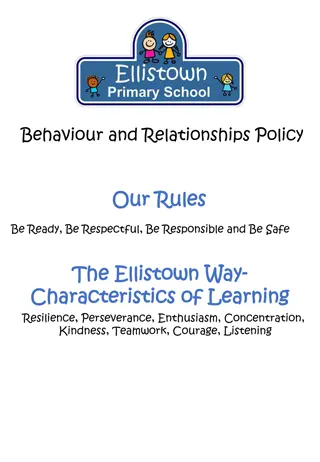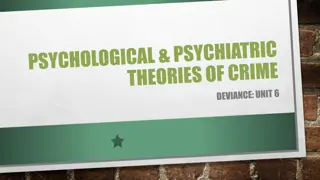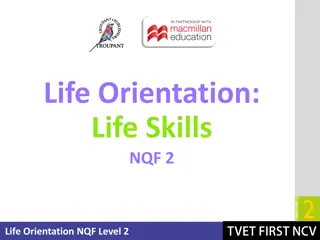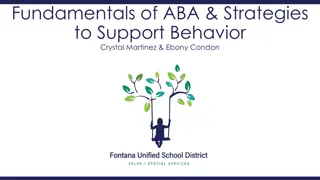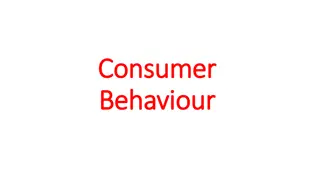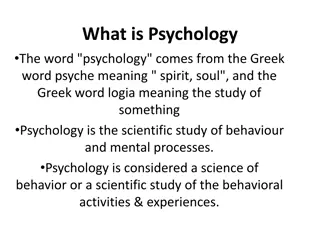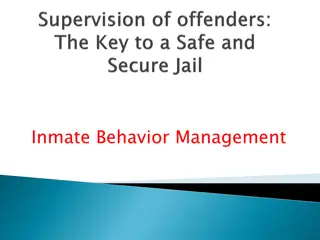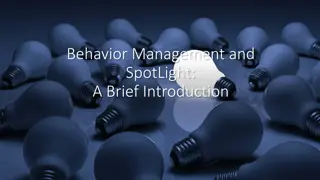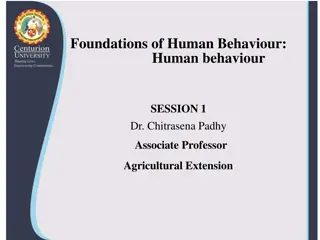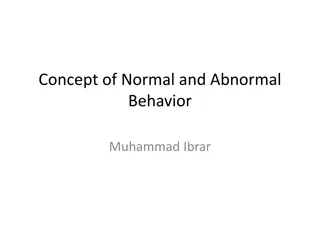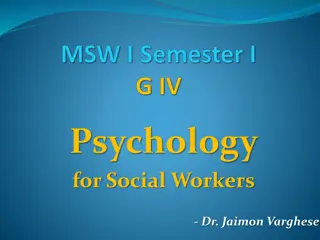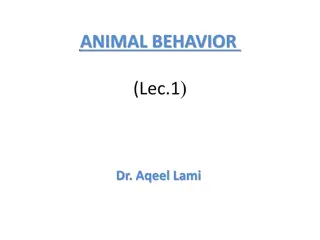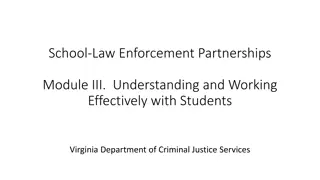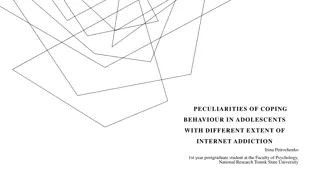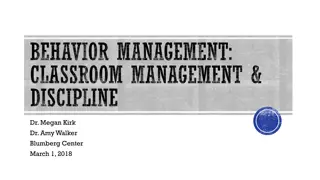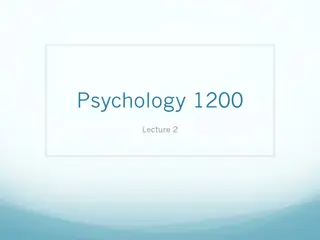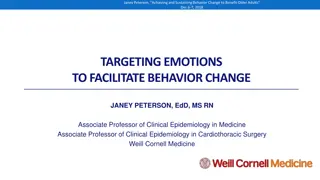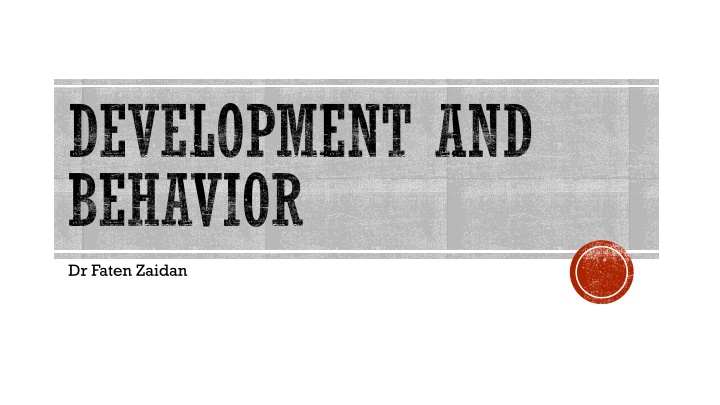
Child Development and Behavior with Dr. Faten Zaidan
Explore the normal development and behavioral aspects in children, as explained by Dr. Faten Zaidan. Learn about factors to consider in development assessment, history screening, primitive reflexes examination, and specific reflexes like Moro, Grasp, Rooting, Gallant, and Placing reflexes.
Download Presentation

Please find below an Image/Link to download the presentation.
The content on the website is provided AS IS for your information and personal use only. It may not be sold, licensed, or shared on other websites without obtaining consent from the author. If you encounter any issues during the download, it is possible that the publisher has removed the file from their server.
You are allowed to download the files provided on this website for personal or commercial use, subject to the condition that they are used lawfully. All files are the property of their respective owners.
The content on the website is provided AS IS for your information and personal use only. It may not be sold, licensed, or shared on other websites without obtaining consent from the author.
E N D
Presentation Transcript
DEVELOPMENT AND BEHAVIOR Dr Faten Zaidan
Definition of normal development: Parallel to the changes in the developing brain (i.e., cognition, language, behavior) are changes in the physical development of the body. FACTORS TO BE CONSIDERED WHILE ASSESSING DEVELOPMENT
THE HISTORY Screening is based on the : history 1. physical and developmental examination 2. interpretation and comparison to normal child at the same age 3. General history: Birth weight and duration of gestation. Prenatal risk factors e.g. infectious, hypertension. Genetic factors: mental sub normality. Familial pattern of development. Perinatal factors e.g. fetal distress. Condition at birth. Postnatal development e.g. when beginning to smile. Sucking or swallowing difficulties, irritability etc. Major illnesses, emotional deprivation, etc. The previous development: Is he showing accelerated development ? or slowing of development (i.e. loss of attained functions) e.g. neurodegenerative diseases? Developmental history: Assess the mother s understanding and memory. Ask whether the baby shows a particular skill (e.g. smiles) and when he began to show it.
Primitive reflexes Examination of the primitive reflexes provides assessment of the functional integrity of the brainstem and basal ganglia, indicating the normal maturation of descending inhibitory cerebral influences. Asymmetry or persistence of the primitive reflexes may indicate focal brain or peripheral nerve lesions
The Moro reflex is elicited by allowing the infants head to gently move back suddenly (from a few inches off of the mattress onto the examiner s hand), resulting in a startle, then abduction and upward movement of the arms followed by adduction and flexion. The legs respond with flexion. MORO REFLEX 2 1
ROOTING REFLEX The rooting reflex is elicited by touching the corner of the infant s mouth, resulting in lowering of the lower lip on the same side with tongue movement toward the stimulus. The face also turns toward the stimulus.
ASYMMETRIC TONIC NECK The asymmetric tonic neck reflex is elicited by placing the infant supine and turning the head to the side. This placement results in ipsilateral extension of the arm and the leg into a fencing position. The contralateral side flexes as well.
PARACHUTE REFLEX 2 1
SUCKING REFLEX The sucking reflex occurs with almost any object placed in the newborn s mouth. The infant responds with vigorous sucking. The sucking reflex is replaced later by voluntary sucking.
STAIRS A) Going up: 18 months old: Two feet on each step with support 2 years old: Two feet on each step without support 3 years old: One foot on each step B) Going down : 2 years old: 2 feet on each step 3 years old: one foot on each step without support
BEHAVIORAL DISORDERS
INFANTILE COLIC Infantile colic is defined as episodes of uncontrollable crying or fussing in an otherwise healthy infant described as paroxysmal and may be characterized by facial grimacing, leg flexion, and passing flatus. Peeks at age of 6 weeks and resolves at age of 3-4 months It is diagnosis of exclusion Fewer than 5% of infants evaluated for excessive crying have an organic etiology. Infantile Colic 2016 ROME IV criteria Age <5 months when the symptoms start and stop Recurrent and prolonged periods of crying, fussing, or irritability that start and stop without obvious cause and cannot be prevented or resolved by caregivers No evidence of poor weight gain, fever, or illness It has been associated with shaken baby syndrome, postpartum depression, parental guilt, and multiple physician visits Caregiver reports of crying/fussing for 3 hours per day on 3 days/week in a telephone or face-to-face interview Total daily crying confirmed to be 3 hours when measured by at least one prospectively kept 24-hour
FULL EXAMINATION IS A MUST The diagnosis of colic is made only when the physical examination reveals no organic cause for the infant s excessive crying. A thorough inspection may identify possible sources of pain (differential diagnosis): - skin lesions - corneal abrasions - hair tourniquets >> - nonaccidental trauma such as bruising or fracture - Cow s milk protein intolerance - gastroesophageal reflux disease (GERD) - maternal substance use including nicotine - poor infant regulation including fatigue, hunger, parental anxiety, and chaotic and disruptive environmental conditions,
APPROACH education (including the natural history and features of colic), demystification, and a discussion of its natural course. Techniques for calming infants include Dr. Harvey Karp s 5 Ss : 1- swaddling 2- side or stomach holding 3- soothing noises (such as shushing, singing, or white noise) 4- swinging or slow rhythmic movement (such as rocking, walking, or riding in a car) 5- sucking on a pacifier
TEMPER TANTRUMS brief episodes of extreme or unpleasant behavior that appear disproportionate to the situation, typically in response to frustration or anger. Behaviors vary and may include whining, crying, screaming, stomping, flailing, head banging, hitting, throwing objects, and biting. Tantrums can instigate breath- holding spells in some children It is normal because of increase in desiring independence,children are often unable to effectively communicate physical needs and emotions. Common triggers of temper tantrums include fatigue, hunger, discomfort, and frustration Temper tantrums usually begin around the age of 12 to 18 months, worsen until 3 years of age, and taper off as children develop increased ability to control emotions, gain independence, and communicate wants and needs. Temper that continues past age of 4 years, last more than 15 minutes, or include harming self or others, is considered abnormal. Tantrums can be more frequent, as well as more aggressive, in children with language delays or underlying conditions. Children with intellectual disability may exhibit tantrums when their developmental age is comparable to 3 to 4 years.
SEPARATION ANXIETY DISORDER (SAD) Separation anxiety is developmentally normal: in infants and toddlers until approximate age 3 4 years Separation anxiety disorder: symptoms usually present after the age of 6 years Excess worrying about own or parent s safety, there will be Nightmares with themes of separation, somatic complaints, and school refusal Social phobia Feeling scared or uncomfortable in one or more social settings (discomfort with unfamiliar peers and not just unfamiliar adults), or performance situations
ENURESIS Repeated voiding of urine into clothes or bed at least twice a week for at least three consecutive months in a child who is at least 5 years of age Types: At 2 4 year, the child is developmentally ready to begin toilet training Girls usually attain bladder control before boys Bowel control typically is achieved before bladder control INVESTIGATIONS For most children with enuresis, the only laboratory test recommended is a clean catch urinalysis with specific gravity to screen for UTI, renal disease, and diabetes mellitus. Urine culture, is based on the urinalysis, to look for UTI A renal ultrasound and/or voiding cystourethrogram (VCUG) is indicated in children with daytime symptoms, recurrent UTI, or concerns for underlying urologic abnormality MRI spine for neurologic findings (urinary retention, constipation, tingling sensation in lower limbs, back pain)
CAUSES OF SECONDARY ENURESIS: chronic or recurrent UTI diabetes mellitus or insipidus Seizures Constipation neurogenic bladder posterior urethral valves, ectopic ureter, vesicoureteral reflux sleep disturbance such as OSA pinworm infection Psychosocial stressors (more common in primary enuresis) mass impinging on the urinary system Combined nocturnal and diurnal enuresis: usually due to congenital urinary tract anomalies. Diurnal incontinence: the most common cause is a paediatric unstable bladder. May occur in girls with a history of sexual abuse.
MANAGEMENT A) First line : Behavioural Parent child education and behavioral approach Charting with rewards for dry nights Voiding before bedtime Night awakening 2 4 h after bedtime, while at the same time making sure that parents do not punish the child for enuretic episodes If behavioural approach fail, Enuresis alarms is indicated for a period of 8 12 weeks 1. 2. 3. 4. 5. B) Second line : Medicine Desmopressin acetate (DDAVP) Side effects: Relapse is high after discontinuation Hyponatremia and may cause seizure due to water intoxication. patient must be educated not to consume an excess of fluids on any evening in which desmopressin is administered. A maximum of one cup of fluid should be offered at the evening meal, and no fluid at all within the 2 h preceding bedtime Treat the cause and refer if needed treat constipation if present 1. 2. 3.
ABNORMAL SLEEP PATTERNS Four stages of sleep Nightmares Occur during REM sleep Child will wake up oriented and will remember the dream Reluctant to return to sleep Easy to arouse Occur during stage 4 NREM sleep, first third of the night The child is screaming, unresponsive for few minutes, then fall back asleep again, and Will not recollect the episode in the morning Parents should provide reassurance during the episode and not vigorously that may awaken the child Rapid return to sleep Stage 4 NREM sleep events, with no recalling in the morning >> non-rapid eye movement (NREM) Night terrors Sleepwalking and sleep talking

